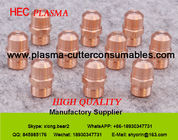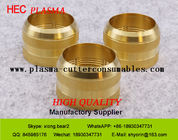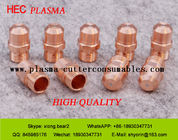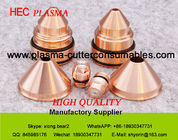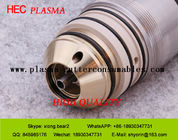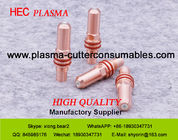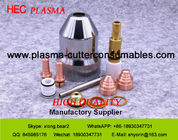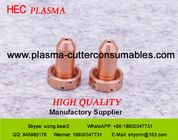Powering Precision: The Critical Role of Plasma Torch Consumables in Modern Metal Cutting
(Focus Keyword: Plasma Torch Consumables)
Subtitle: Understanding Components Like Nozzles, Electrodes, and Shields is Key to Optimal Cutting Performance and Cost Efficiency
In the high-stakes world of metal fabrication, plasma cutting remains a cornerstone technology for its speed, versatility, and ability to handle diverse materials from stainless steel and aluminum to copper and carbon steel. Yet, the true engine driving consistent, high-quality cuts isn't just the plasma cutter itself – it's the often-overlooked plasma torch consumables. Components like nozzles, electrodes, shields, and swirl rings are the frontline heroes, directly impacting cut quality, productivity, and operational costs.
What are Plasma Torch Consumables & Why Do They Matter?
Plasma torch consumables form the critical assembly at the tip of the plasma torch where the intense plasma arc is generated and controlled. This arc, reaching temperatures exceeding 20,000°C, melts the metal, while a high-velocity gas stream blows the molten material away to create the cut. The plasma cutter parts within this assembly endure extreme heat and electrical stress, gradually wearing down and requiring regular replacement – hence the term "consumables."
Key components include:
-
Nozzle: Focuses and constricts the plasma arc and gas flow. Different nozzle designs (e.g., Miller part numbers 262643, 249929, 249935) are optimized for specific amperages (40A, 60A) or tasks (like gouging).
-
Electrode: Carries the electrical current necessary to initiate and sustain the plasma arc (e.g., Miller 256026). Its tip erodes over time.
-
Shield (Retaining Cap/Drag Shield/Deflector): Protects the nozzle from molten splash-back and helps control the secondary gas shield, improving cut quality and nozzle life (e.g., Miller 256027, 256030, 256031, 265226).
-
Swirl Ring: Imparts a swirling motion to the plasma gas, stabilizing the arc and centering it within the nozzle for more consistent cuts (e.g., Miller 256028).
The Direct Impact on Performance and Cost
The condition and quality of these plasma cutting consumables directly influence several critical factors:
-
Cut Quality: Worn or damaged consumables cause poor edge squareness, excessive dross (re-solidified metal slag), uneven kerf width, and increased top edge rounding.
-
Cutting Speed: Optimal consumable condition allows for achieving and maintaining the manufacturer's recommended cutting speeds for a given material thickness. Deteriorating parts force slower speeds to maintain quality.
-
Consumable Life & Operating Cost: High-quality plasma torch accessories designed to exacting standards (like genuine Miller parts or reputable OEM alternatives) typically offer longer life, reducing the frequency of costly changeovers and part replacements. Factors like proper amperage setting, correct gas pressure/flow, and maintaining optimal torch height (typically 2-4mm) significantly extend consumable life.
-
Arc Stability & Reliability: Properly functioning consumables ensure a stable plasma arc, reducing the risk of unexpected torch failures or arc outages during critical cuts.
Optimizing Plasma Cutting Operations
Understanding the interplay between plasma cutter consumables and cutting parameters is vital for efficiency:
-
Cutting Current: Must be matched to the consumable rating and material thickness. Exceeding amperage drastically shortens life.
-
Cutting Speed: Too slow overheats the nozzle; too fast results in incomplete cuts ("lag lines") and poor quality.
-
Working Gas: The choice of gas (compressed air, nitrogen, oxygen, argon/hydrogen mixes) affects cut quality, consumable life, and is often specified by the consumable type. Correct flow rate is crucial – too low fails to clear molten metal; too high destabilizes the arc.
-
Torch Height Control: Maintaining a consistent standoff distance protects the consumables and ensures consistent energy transfer.
The Evolving Market: Genuine vs. Quality Alternatives
While genuine manufacturer parts (like Miller plasma consumables for XT60 torches) ensure perfect compatibility and performance, a robust market exists for high-quality OEM plasma torch parts. Brands like AJAN offer compatible electrodes (E0, E1, E2, E3, E4), nozzles (N1-N8), shields (S1-S4), and swirl rings (SW1-SW3), providing cost-effective alternatives without necessarily sacrificing performance or longevity for many applications. Choosing reputable suppliers is key.
Conclusion: Invest in the Tip for Peak Performance
Plasma torch consumables are far from mere disposable items; they are precision-engineered components fundamental to achieving efficient, high-quality, and cost-effective plasma cutting. By selecting the correct parts (like nozzles 262643 or 249929, shields 256027 or 256030), adhering to optimal operating parameters, and implementing a proactive maintenance and replacement schedule, metal fabricators can maximize their plasma cutter's uptime, minimize operational costs, and consistently deliver superior results. Understanding and investing in these critical plasma cutting machine consumables is essential for any competitive fabrication operation.

 Your message must be between 20-3,000 characters!
Your message must be between 20-3,000 characters! Please check your E-mail!
Please check your E-mail!  Your message must be between 20-3,000 characters!
Your message must be between 20-3,000 characters! Please check your E-mail!
Please check your E-mail! 


